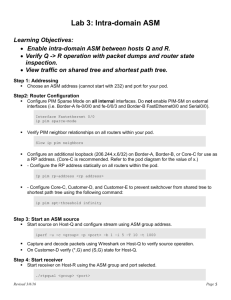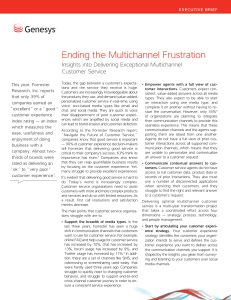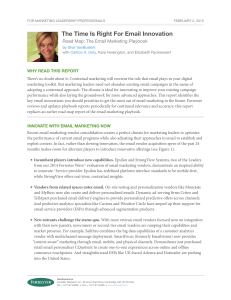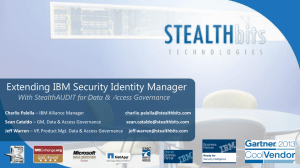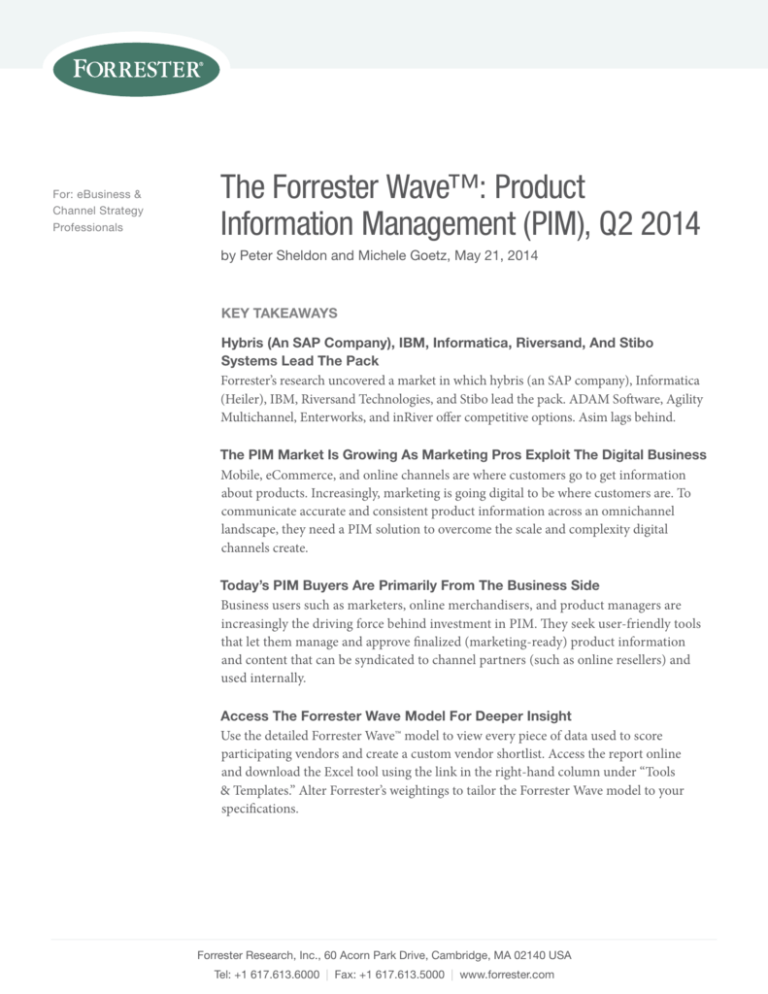
For: eBusiness &
Channel Strategy
Professionals
The Forrester Wave™: Product
Information Management (PIM), Q2 2014
by Peter Sheldon and Michele Goetz, May 21, 2014
Key Takeaways
Hybris (An SAP Company), IBM, Informatica, Riversand, And Stibo
Systems Lead The Pack
Forrester’s research uncovered a market in which hybris (an SAP company), Informatica
(Heiler), IBM, Riversand Technologies, and Stibo lead the pack. ADAM Software, Agility
Multichannel, Enterworks, and inRiver offer competitive options. Asim lags behind.
The PIM Market Is Growing As Marketing Pros Exploit The Digital Business
Mobile, eCommerce, and online channels are where customers go to get information
about products. Increasingly, marketing is going digital to be where customers are. To
communicate accurate and consistent product information across an omnichannel
landscape, they need a PIM solution to overcome the scale and complexity digital
channels create.
Today’s PIM Buyers Are Primarily From The Business Side
Business users such as marketers, online merchandisers, and product managers are
increasingly the driving force behind investment in PIM. They seek user-friendly tools
that let them manage and approve finalized (marketing-ready) product information
and content that can be syndicated to channel partners (such as online resellers) and
used internally.
Access The Forrester Wave Model For Deeper Insight
Use the detailed Forrester Wave™ model to view every piece of data used to score
participating vendors and create a custom vendor shortlist. Access the report online
and download the Excel tool using the link in the right-hand column under “Tools
& Templates.” Alter Forrester’s weightings to tailor the Forrester Wave model to your
specifications.
Forrester Research, Inc., 60 Acorn Park Drive, Cambridge, MA 02140 USA
Tel: +1 617.613.6000 | Fax: +1 617.613.5000 | www.forrester.com
For eBusiness & Channel Strategy Professionals
May 21, 2014
The Forrester Wave™: Product Information Management
(PIM), Q2 2014
Hybris (An SAP Company), IBM, Informatica, Riversand, And Stibo Systems Lead The
Pack, With A Robust Set Of Midmarket Players Close Behind
by Peter Sheldon and Michele Goetz
with Zia Daniell Wigder and Rebecca Katz
Why Read This Report
In Forrester’s 19-criteria evaluation of product information management (PIM) vendors, we identified the
10 most significant providers in the category — ADAM Software, Agility Multichannel, asim, Enterworks,
hybris (an SAP company), IBM, Informatica, inRiver, Riversand Technologies, and Stibo Systems — and
researched, analyzed, and scored them in three areas: current offering, strategy, and market presence. This
report details our findings about how well each vendor fulfills our criteria and where they stand in relation
to each other to help eBusiness and channel strategy professionals select the right partner for their product
information management needs.
Table Of Contents
Notes & Resources
2 PIM Is An Imperative For Managing A
Customer-Facing Product Strategy
Forrester conducted lab-based evaluations
in December 2013 and interviewed 10
vendor and user companies: ADAM Software,
Agility Multichannel, asim, Enterworks, hybris
(an SAP company), IBM, Informatica, inRiver,
Riversand Technologies, and Stibo Systems.
3 PIM Is For Business; MDM Is For Technology
Management
6 Product Information Management (PIM)
Evaluation Overview
7 Vendor Selection Criteria
Related Research Documents
9 PIM Leaders Excel At Omnichannel
Management And Orchestration
The Forrester Wave™: Master Data
Management Solutions, Q1 2014
February 3, 2014
12 Vendor Profiles
Leaders
Strong Performers
Contenders
15 Supplemental Material
Market Overview: Digital Asset Management,
2014
January 24, 2014
It’s Time To Revisit Product Information
Management (PIM)
July 21, 2009
© 2014, Forrester Research, Inc. All rights reserved. Unauthorized reproduction is strictly prohibited. Information is based on best available
resources. Opinions reflect judgment at the time and are subject to change. Forrester®, Technographics®, Forrester Wave, RoleView, TechRadar,
and Total Economic Impact are trademarks of Forrester Research, Inc. All other trademarks are the property of their respective companies. To
purchase reprints of this document, please email clientsupport@forrester.com. For additional information, go to www.forrester.com.
For eBusiness & Channel Strategy Professionals
2
The Forrester Wave™: Product Information Management (PIM), Q2 2014
Pim Is An Imperative For Managing A Customer-Facing Product Strategy
As consumers spend more time researching product purchases online, the importance of highquality product content becomes paramount for retailers, manufacturers, CPG firms, and
distributors alike. In fact, retailers are prioritizing the enhancement of online product content above
other merchandising initiatives including personalization, product recommendations, and A/B
testing.1 Why? Detailed product content is a differentiator when it comes to customer experience.
Thirty percent of US online adults cite that they would consider buying from an online retailer they
had never previously purchased from if the retailer offered detailed product information.2
With customer demands for high-quality, consistent product information and content on the rise,
a new breed of PIM buyers has emerged. They are the brand marketers, online merchandisers, and
product owners responsible for the sales and marketing of finished merchandise to the customer. At
many organizations today, these individuals all too often rely on manual processes and home-grown
tools (commonly MS Excel) to manage the consolidation of product data from back-office systems
and other disparate data sources across the enterprise. While these home-grown solutions may
have served them well in the past, Forrester has observed a considerable uptick in client inquiries
asking about how PIM solutions can replace this status quo. Furthermore, in a recent survey, 33%
of eBusiness and channel strategy professionals cited that investment in PIM technology was a top
priority.3 Although the buyer of a PIM solution is not always the same from client to client and the
needs of a retailer can differ from those of an industrial manufacturer or CPG firm, Forrester has
observed common scenarios that lead customer-obsessed organizations to invest in PIM. These
include the need to:
■ Have a single view of trusted customer-facing product data. Industrial, brand, and CPG firms
that manufacture their own products have long invested in PIM (either standalone or as part of
their ERP infrastructure) to manage buy-side supply-chain-related product data such as item
dimensions and weights. However, the business side of the house also has a need for PIM. It
needs a single repository for consumer-ready, trusted, and approved product content that can
be made accessible across the enterprise to internal users (brand managers, marketing, account
managers) and that also can be made accessible to external channel partners, such as retail
distributors and resellers.
■ Reduce time-to-market for new product launches. Product life cycles are getting shorter.
Brands and retailers alike need to get new products quickly into the hands of customers, and
this means streamlining the processes for creating, approving, publishing, and syndicating
consumer-ready product content. Today manual processes hinder this goal, but with PIM, many
stages of the product content creation life cycle can be automated.
© 2014, Forrester Research, Inc. Reproduction Prohibited
May 21, 2014
For eBusiness & Channel Strategy Professionals
3
The Forrester Wave™: Product Information Management (PIM), Q2 2014
■ Support larger product catalogs. Many retailers are increasing the number of SKUs they sell
online by a factor of five to 10 times. The industry calls this the “endless aisle,” and for retailers
it is a necessity to stay relevant in an era where Amazon sell almost every conceivable consumer
merchandise category. Brands, too, are increasing the number of SKUs they offer with new subbrands, private-label products, and general diversification of product lines. All of this means
that existing home-grown product management systems and manual processes are bursting at
the seams. PIM provides a scalable solution that enables firms to rapidly increase the SKUs and
products they sell without having to worry about system scalability.
■ Support increasingly demanding channel distribution partners. From video and high-
resolution imagery through to detailed product specs and even supply chain data, savvy online
retailers like Amazon and Walmart are becoming increasingly demanding. The rules of the
game are changing, and manufacturers, brands, and CPGs that want to distribute via these
online channel powerhouses must play by their rules. PIM provides the governance and process
orchestration tools needed to manage unique product content needs for individual channel
partners as well as the tools to syndicate out product content in the required format and
specifications defined in downstream channel partner trading agreements.
■ Ensure a consistent cross-channel customer experience. No matter which channel a product
is being sold through, retailers and brands alike must ensure that customers receive a consistent
experience. For example, CPG firms must ensure (often for the purposes of regulatory
compliance) that their products have the correct and most up-to-date information across online
retail sites, print catalogs, store displays, kiosks, and mobile. Failure to do so can often result
in consumers being misled into buying the wrong products or products that do not meet their
specified expectations, which in turn affects return rates, customer satisfaction, and brand
advocacy metrics — and ultimately margin.
Pim Is For Business; Mdm Is For Technology Management
Forrester often sees clients confused about what tools are best suited to manage the quality and
consistency of product information. On the one hand, there are master data management tools. On
the other, there are product information management tools. Each appears to solve the same set of
challenges to manage product data, yet it becomes obvious during vendor demonstrations that these
tools are very different. Business users such as marketers can readily identify with the application
look and feel of product information management that offers an intuitive environment for managing
product data and associated content. Data management professionals are drawn to master data
management solutions that are obvious extensions to their data management tools, such as extracttransform-load (ETL), data quality, and metadata management, and help them with data integration
demands. So how should organizations orient themselves to determine whether a PIM tool is the
right choice? There are three options to consider (see Figure 1):
© 2014, Forrester Research, Inc. Reproduction Prohibited
May 21, 2014
For eBusiness & Channel Strategy Professionals
4
The Forrester Wave™: Product Information Management (PIM), Q2 2014
■ PIM pure-play. This option is concerned with how product information is presented outwardly
through sales and marketing channels (e.g., an online store). Business users need an application
that maintains catalogs, bringing together the attributes of products with merchandising
elements such as images, video, audio, descriptions, and bundles. PIM addresses the dynamic
nature of constructing and reconstructing compelling packages and offers in an environment
that nontechnical user can work in. Critical capabilities are product visualization, workflow
management, discrete and mass product updates and refreshes, and seamless integration with
content tools (content management, digital asset management, print, eCommerce, etc.) for
product definitions/bundles and workflow.
■ MDM pure-play. The management and orchestration of product data and elements across
applications and data sources is the strength of master data management (MDM) tools.
Where PIM may be the system of record for the outward view of product information, MDM
manages the complexity of gathering product data, syndicating the data to other systems,
and providing consistency and linkage of product data to other master data domains (i.e.,
customer, supplier, location, etc.). Linkage to content may be maintained in the form of
metadata to link by a tag or file but it is not presented natively within the MDM tool. From a
user standpoint, the environment is typically oriented for technology management, although
data professionals in business operations are also common users. Critical capabilities are data
integration, multidomain data modeling, data quality and matching, data governance, metadata
management, and multiplatform support (i.e., RDBMS, Hadoop/NoSQL, applications, etc.).
■ Hybrid PIM/MDM solution. Many PIM vendors offer their own MDM standalone tools or
have MDM capabilities integrated into their PIM tools. This is due to the fact that a mature PIM
capability within a complex omnichannel ecosystem requires a front-end business solution and
a robust back-end engine. PIM vendors may present their tools as MDM for other domains, as
PIM will often contain non-product data such as supplier information. However, the nature of
the environment is optimized for a product view and product management workflows. Forrester
recommends that organizations use their MDM tools as the engine and orchestration point
across multiple domains and include PIM as the business application for business users to
manage the product catalog(s) (see Figure 2).
Yes, you can model products in an MDM solution, but the tool set is not well suited for business
users (brand marketers, product managers), plus PIM solutions have a niche set of capabilities
tailored to the specifics of managing products (e.g., product relationships).
© 2014, Forrester Research, Inc. Reproduction Prohibited
May 21, 2014
For eBusiness & Channel Strategy Professionals
5
The Forrester Wave™: Product Information Management (PIM), Q2 2014
Figure 1 PIM Looks And Feels Like MDM, But It’s Really An App
And manages these product
life-cycle processes:
Acronym: Stands for:
Is defined as:
PIM
Product
information
management
An enterprise application enabling
an organization to identify or
derive trusted product data across
heterogeneous data environments,
enabling transactional, bidirectional
synchronization across upstream
production sources, downstream
analytical target systems, and
external trading communities and
data sync networks
1) Validate and source; 2) market and
promote; 3) produce and sell;
4) support and retire.
Product
MDM
Product
master data
management
A business capability specifically
focused on identifying trusted
product data and then leveraging
that data to improve product-datadependent business processes
and decisions
Validate only. A product master in
an MDM hub will not automate the
other PLM processes as defined above.
It will only validate the single version of
truth for product data and synchronize
that truth with the applications that
manage these dependent upstream
and downstream processes.
108002
© 2014, Forrester Research, Inc. Reproduction Prohibited
Source: Forrester Research, Inc.
May 21, 2014
For eBusiness & Channel Strategy Professionals
6
The Forrester Wave™: Product Information Management (PIM), Q2 2014
Figure 2 PIM Success Acknowledges The Broader Ecosystem
Business users and consumers
Email
Portal
eCommerce
Web
SEO/SEM
Mobile
Buyers/merchandising/
suppliers/data stewards
PLM
Social
PIM
ERP
WCM/
CMS
DAM
MDM
Data sources
Data
quality
Marketing
Product
management
Catalog
Product data feeds
(Product exchange)
Data management professionals
108002
Source: Forrester Research, Inc.
Product Information Management (Pim) Evaluation Overview
To assess the state of the PIM market and see how the vendors stack up against each other, Forrester
evaluated the strengths and weaknesses of 10 leading PIM vendors. After examining past research, user
need assessments, and vendor and expert interviews, we developed a comprehensive set of evaluation
criteria. We evaluated vendors against 19 criteria, which we grouped into three high-level buckets:
■ Current offering. The criteria we selected to assess the strength of companies’ current offerings
reflect the needs of both eBusiness and enterprise architecture professionals — i.e., we included
technical integration and systems governance criteria alongside criteria that evaluated the
effectiveness of the business user tools for end users. We evaluated each offering against nine
groups of criteria: architecture and scalability; integration and syndication; workflow, approval,
and business process support; product taxonomy and relationship management; product
attribute management; roles and privileges; administration tools; vendor portal tools; and data
quality management, governance, and reporting.
© 2014, Forrester Research, Inc. Reproduction Prohibited
May 21, 2014
For eBusiness & Channel Strategy Professionals
7
The Forrester Wave™: Product Information Management (PIM), Q2 2014
■ Strategy. We compared the strategies of each company with the needs of eBusiness and
enterprise architecture executives, industry trends, and Forrester’s forward-looking vision of
the PIM market to assess how well each vendor is positioned for future success. We examined
each vendor’s road map, planned product enhancements, target market, focus on PIM, key
technology partners, implementation providers, and cost of ownership.
■ Market presence. Many firms today support their PIM needs with home-grown technology
or legacy solutions no longer supported by the vendor community. eBusiness and enterprise
architecture executives must look for vendors that have a strong and stable installed base,
demonstrate steady growth, and offer a solid network of implementation and supports partners.
To determine the current market presence for our evaluation, we combined information about
each vendor’s installed base, new customers, revenue, revenue growth, global presence, and
vertical market penetration.
Vendor Selection Criteria
In this Forrester Wave, Forrester evaluated vendors that offer standalone PIM solutions targeted
at distributors, retailers, CPG, and manufacturing firms. Forrester included 10 vendors in the
assessment: ADAM Software, Agility Multichannel, asim, Enterworks, hybris (an SAP company),
IBM, Informatica, inRiver, Riversand Technologies, and Stibo Systems (see Figure 3). Although PIM
capabilities are sometimes found embedded within other software product categories (e.g., ERP
systems), only the 10 vendors included in this evaluation have:
■ An established enterprise PIM offering. A participating player must actively market a
productized PIM solution. The vendor must have initially released the product version included
in the evaluation prior to October 2013.
■ A standalone offering for PIM. Beyond the ability to support product data in a broader
MDM solution or within an ERP or eCommerce platform, these vendors offer standalone PIM
enterprise applications with unique capabilities that allow them to validate and source, market
and promote, produce and sell, and support and retire products.
■ A focused product road map. Each of the vendors evaluated has a focused product road map
that aligns with the direction of the market and emerging scenarios tracked by Forrester.
■ Mindshare among the Forrester client base. The vendors we evaluated are frequently
mentioned in Forrester client inquiries, shortlists, consulting projects, and case studies.
■ A focus on retail, distribution, CPG, and manufacturing verticals. Beyond the ability to
support product data in a broader MDM solution, these vendors have rich support for the
unique needs of retailers, distributors, CPG firms, and manufacturers.
© 2014, Forrester Research, Inc. Reproduction Prohibited
May 21, 2014
For eBusiness & Channel Strategy Professionals
8
The Forrester Wave™: Product Information Management (PIM), Q2 2014
Figure 3 Evaluated Vendors: Vendor Information And Selection Criteria
Vendor
Product Name
ADAM Software
Product Content Management (PCM)
Agility Multichannel
Agility
asim
asimSuite
Enterworks
Enable
hybris
Master Data Management
IBM
InfoSphere Master Data Management Collaborative Edition
Informatica
Informatica PIM (Product Information Management)
inRiver
inRiver PIM
Riversand Technologies
Product Information Management (PIM)
Stibo Systems
STEP
Vendor selection criteria
An established enterprise PIM offering. A participating player must actively market a productized PIM
solution. The vendor must have initially released the product version included in the evaluation prior to
October 2013.
A standalone offering for PIM. Beyond the ability to support product data in a broader MDM solution or
within an ERP or eCommerce platform, these vendors offer standalone PIM enterprise applications with
unique capabilities that allow them to validate and source, market and promote, produce and sell, and
support and retire products.
A focused product road map. Each of the vendors evaluated has a focused product road map that aligns
with the direction of the market and emerging scenarios tracked by Forrester.
Mindshare among the Forrester client base. The vendors we evaluated are frequently mentioned in
Forrester client inquiries, shortlists, consulting projects, and case studies.
A focus on retail, distribution, CPG, and manufacturing verticals. Beyond the ability to support
product data in a broader MDM solution, these vendors have rich support for the unique needs of
retailers, distributors, CPG firms, and manufacturers.
Source: Forrester Research, Inc.
© 2014, Forrester Research, Inc. Reproduction Prohibited
May 21, 2014
For eBusiness & Channel Strategy Professionals
9
The Forrester Wave™: Product Information Management (PIM), Q2 2014
Pim Leaders Excel At Omnichannel Management And Orchestration
The evaluation uncovered a market in which (see Figure 4):
■ Hybris (an SAP company), IBM, Informatica, Riversand, and Stibo Systems lead the pack.
These vendors have all been in the PIM game for over a decade, and consequently all five bring
to the table a robust and comprehensive set of capabilities. They each seamlessly balance the
requirements to manage product data to acquire, retain, and grow customers while addressing
the underlying complexity of product data quality, consistency, and omnichannel orchestration.
Furthermore, all of them either offer robust integration with their own eCommerce solutions or
have strong partnerships in place with the leading eCommerce platform vendors.
■ ADAM Software, Agility Multichannel, Enterworks, and inRiver offer competitive options.
Each of these vendors offers unique PIM capabilities for clients. Their strengths are oriented
toward the front-end business capabilities marketers have for catalog management. However,
their offerings are often focused on particular industries, channels, or size of catalogs. These
vendors typically lack more robust data quality, integration, and master data management
capabilities and thus are commonly a right-size fit for midmarket retailers, distributors, or
manufacturers that need to empower their digital marketing and brand teams to manage a
single view of trusted product data, but where a smaller user base reduces the need for highly
complex approval workflows and governance enforcement.
■ Asim lags behind. Asim is a niche solution targeted primarily at industrial manufacturers. The
solution suffers from a number of limitations but may be a fit for manufacturers looking to
manage a complex taxonomy of parts.
This evaluation of the PIM market is intended to be a starting point only. We encourage clients to
view detailed product evaluations and adapt criteria weightings to fit their individual needs through
the Forrester Wave Excel-based vendor comparison tool.
© 2014, Forrester Research, Inc. Reproduction Prohibited
May 21, 2014
For eBusiness & Channel Strategy Professionals
10
The Forrester Wave™: Product Information Management (PIM), Q2 2014
Figure 4 Forrester Wave™: Product Information Management (PIM), Q2 ’14
Risky
Bets
Contenders
Strong
Performers
Leaders
Strong
Riversand Technologies
ADAM Software
Informatica
IBM
hybris
Agility Multichannel
Stibo Systems
Enterworks
inRiver
Go to Forrester.com to
download the Forrester
Wave tool for more
detailed product
evaluations, feature
comparisons, and
customizable rankings.
Current
offering
asim
Market presence
Weak
Weak
Strategy
Strong
Source: Forrester Research, Inc.
© 2014, Forrester Research, Inc. Reproduction Prohibited
May 21, 2014
For eBusiness & Channel Strategy Professionals
11
The Forrester Wave™: Product Information Management (PIM), Q2 2014
Forrester’s
Weighting
ADAM Software
Agility Multichannel
asim
Enterworks
hybris
IBM
Informatica
inRiver
Riversand Technologies
Stibo Systems
Figure 4 Forrester Wave™: Product Information Management (PIM), Q2 ’14 (Cont.)
CURRENT OFFERING
Architecture and scalability
Integration and syndication
Workflow, approval, and
business process support
Product taxonomy and
relationship management
Product attribute management
Roles and privileges
Administration tools
Vendor portal tools
Data quality management,
governance, and reporting
50%
7%
15%
15%
3.54
3.20
3.30
5.00
3.69
3.80
3.00
5.00
2.22
2.60
1.00
3.00
3.05
2.40
2.10
3.00
3.84
4.00
4.70
4.00
3.93
3.00
4.70
5.00
4.36
4.60
4.70
5.00
3.02
2.80
2.70
5.00
3.74
3.80
4.10
4.00
3.83
4.20
4.50
4.00
15%
4.00 4.00 3.00 4.00 4.00 4.00 4.00 3.00 4.00 4.00
15%
10%
8%
5%
10%
3.40
4.20
3.20
2.00
1.80
STRATEGY
Product road map and
strategic direction
Target market and
enterprise track record
Partner network,
professional services, and
vendor-provided services
Solution implementation
Cost of ownership
50%
40%
3.30 3.10 2.00 2.90 4.70 4.10 4.40 3.00 3.50 4.40
4.00 3.00 2.00 3.00 5.00 3.00 4.00 3.00 4.00 4.00
30%
2.00 3.00 2.00 3.00 5.00 5.00 5.00 2.00 3.00 5.00
20%
4.00 3.00 2.00 2.00 4.00 5.00 5.00 4.00 3.00 5.00
10%
0%
3.00 4.00 2.00 4.00 4.00 4.00 3.00 4.00 4.00 3.00
4.00 4.00 4.00 4.00 2.00 2.00 3.00 4.00 3.00 2.00
0%
30%
15%
25%
15%
1.75
2.00
3.00
1.00
1.00
15%
2.00 3.00 2.00 2.00 4.00 5.00 4.00 2.00 3.00 4.00
MARKET PRESENCE
Revenue
Revenue growth
Customer base
New customers
(past 12 months)
Geographic and
vertical market penetration
3.20
3.60
4.00
4.00
2.60
2.70
2.00
4.00
3.00
2.00
2.20
2.60
2.00
2.00
1.40
2.00
2.00
3.00
2.00
1.00
3.00
3.20
1.80
4.00
4.00
2.10
2.00
3.00
3.00
0.00
3.80
3.60
4.20
1.00
3.40
4.15
4.00
5.00
4.00
4.00
3.80
4.40
3.20
2.00
3.00
4.40
4.00
3.00
5.00
5.00
4.00
4.40
4.00
4.00
4.20
4.00
4.00
4.00
4.00
4.00
1.80
2.60
2.20
3.00
3.60
3.00
2.00
5.00
3.00
4.00
3.20
3.60
3.80
3.00
3.60
2.9
3.00
5.00
2.00
2.00
3.20
3.00
3.20
4.00
4.20
4.55
5.00
4.00
5.00
4.00
All scores are based on a scale of 0 (weak) to 5 (strong).
Source: Forrester Research, Inc.
© 2014, Forrester Research, Inc. Reproduction Prohibited
May 21, 2014
For eBusiness & Channel Strategy Professionals
12
The Forrester Wave™: Product Information Management (PIM), Q2 2014
Vendor Profiles
Leaders
■ Hybris (an SAP company). Though best known as a commerce provider, hybris started life as
a PIM solution, with commerce capabilities added later in the product evolution. Today, hybris
continues to offer PIM as a standalone offering, although many clients purchase licenses for
both the PIM and eCommerce modules together. Unlike the other PIM vendors included in this
Forrester Wave that have partnerships with eCommerce platforms, hybris is unique in having
a combined and tightly integrated PIM/eCommerce offering that is built on the same flexible
Java architecture and data model. Hybris therefore appeals to manufacturers, CPG firms, and
retailers that have both PIM and eCommerce project priorities. The combined solution negates
the need to develop bespoke integrations and provides a strong set of business user tools (the
hybris PIM cockpit) focused on supporting the needs of business-focused, merchandising,
eCommerce, and marketing roles. Now part of SAP, the hybris PIM will complement SAP’s
own enterprise information management (EIM) portfolio, and going forward, hybris PCM will
become SAP’s strategic product catalog solution. The firm is already developing productized
integrations between the hybris product content management (PCM) product and SAP’s own
master data governance and PIM solutions. These integrations will intentionally be loosely
coupled to allow for customer-specific implementations.
■ IBM. IBM’s PIM solution dates back to the acquisition of Trigo Technologies in 2004. Today
the firm offers both MDM/PIM capabilities under the umbrella of its Infosphere MDM solution
set, with the PIM-specific capabilities available through both the Collaborative Edition and
the Enterprise Edition. For prospective clients that are looking to IBM to fulfill both PIM
and eCommerce requirements, the company offers a bundled integration package, Advanced
Catalog Management (ACM), which provides prebuilt data model mapping and workflow
integrations between InfoSphere MDM (CE) and WebSphere Commerce. However, clients
should be aware that the business user tools are not integrated. The UI is dated, and while
it offers powerful functionality for super users or data stewards, business-facing or external
users may require training. IBM has a global and experienced suite of PIM implementation
partners, as well as solution and technology partners that provide vertical-specific capabilities
and accelerators to the core platform. Beyond the core verticals of retail, distribution, and
manufacturing, IBM has a solid installed base among financial services, telecom, and healthcare
firms that primarily sell services rather than physical goods.
■ Informatica. Informatica purchased Heiler in late 2012 and immediately focused on the
integration of Informatica Data Quality and on extending Heiler’s deployment options. Working
with an already strong foundation to manage product taxonomies and relationships, Informatica
PIM has one of the most complete sets of deployment, quality, and data management
capabilities for PIM. Solid visualization, complex catalog management with inheritance, and
strong workflow capabilities help business users create, manage, and govern product data.
© 2014, Forrester Research, Inc. Reproduction Prohibited
May 21, 2014
For eBusiness & Channel Strategy Professionals
13
The Forrester Wave™: Product Information Management (PIM), Q2 2014
Informatica PIM workflow is extensive and can be further deployed upstream and downstream
using Informatica BPM. Linking product data with content and assets supports merchandising.
Informatica PIM does a nice job of capturing events and detailed metadata for product changes,
although it is lighter on an audit trail for business process, vendor management, and business
performance. Overall, the reason customers choose Informatica PIM is its usability to support a
multichannel environment.
■ Riversand Technologies. Riversand customers have an extensive array of deployment
options for complex multichannel environments. Product information can be configured and
controlled to match any display option from mobile, eCommerce, print, email, or SEO, to name
a few. In addition, data quality runs in the delivery process and notifies product teams and
merchandisers of errors or issues. Riversand is highly scalable to support a large number of
users and offers a wide set of language options. The solution has a tightly integrated DAM with
embedded image/video editing and rendering features. Customers also appreciate the ability to
bulk-load and manipulate product data, although some reported challenges with integration
setup and business workflow rules design. However, customers indicate that Riversand is highly
responsive and partners well. It works to resolve issues in production and evolve its product in
alignment with customers’ PIM needs and challenges.
■ Stibo Systems. Stibo excels in integration with real-time systems, providing a multitude
of transport and format options. Web service APIs based on SOAP and REST come out of
the box and stay tightly coordinated with data model changes. Workflow management and
tracking is standard to support the creation of product catalogs and requires more support
from technology management. However, business users can receive Smart Excel files to make
changes and added product data and attributes that integrate with the PIM solution. Customers
appreciate the experience and responsiveness of Stibo to help with the technology as well as
best practices to manage and govern product data. Stibo rapidly deploys new functionality to
meet market demands; customers have also said that updates are sometimes so frequent that it
is difficult to keep up. In general, customers are happy that they could start small with Stibo, and
the solution scales well as the volume of products increases.
Strong Performers
■ ADAM Software. New to the PIM market, ADAM Software builds upon its history as a digital
asset management (DAM) vendor and plays on the strength of display merchandising to
support catalog and eCommerce objectives. Customer feedback indicates this has created a
superior user interface to move back and forth between PIM and DAM. Deployment options
are extensive across the Microsoft server environment, Amazon EC2, and flexible integration
with SSIS. The environment is clean and business-friendly, with business users able to view
and navigate through products and build offers on their own. Emphasis on support for
merchandising and marketing features has overshadowed investment in the data quality, bulk
© 2014, Forrester Research, Inc. Reproduction Prohibited
May 21, 2014
For eBusiness & Channel Strategy Professionals
14
The Forrester Wave™: Product Information Management (PIM), Q2 2014
update, and product detail import feeds. This has created customer challenges when products
have an extensive number of attributes to manage. References cited that search and the user
interface could be improved. ADAM Software does not currently offer portal capabilities, but
suggests using RESTful APIs to connect with web portals or integrate with business process
management services. Overall, ADAM Software’s PIM strength is the ability to support the
preparation of product information at the point of engagement with customers with little to
no support from technology management, making it a true business solution, not just a data
management solution.
■ Agility Multichannel. Unlike other vendors, Agility Multichannel positions its software, Agility,
as a PIM pure-play rather than a hybrid PIM/MDM solution. For customers with complex data
integration needs that may be looking for heavyweight MDM functionality, the firm’s integrated
OEM relationship with Pentaho solves for both data integration and business analytics. At the
heart of the Agility offering is the user interface Agility Modular Interface (AMI), which can
be highly customized for the specific needs of various end users through the creation of rolespecific workspaces. The product ships with a library of widgets that allow for individual roles
(e.g., product managers, online merchandisers, and suppliers) to design optimized workflows
from a single web-based tool set. Agility Multichannel is already working with partners to build
a development ecosystem around AMI that will see third-party widgets added to the library
in due course. The solution is well suited for firms that need to syndicate product content to
multiple channels and includes integration with Adobe’s Creative Cloud for print as well as
mature connectors for most of the leading eCommerce platforms.
■ Enterworks. Business users have a friendly environment to manage product hierarchies, offers,
and content, including digital asset management capabilities. The portal offers a complete
workbench that provides visibility into the state and quality of product data and workflows.
Additionally, business users are able to configure product attributes and taxonomies without
technology management and do so across multiple catalogs maintaining inheritance. Customers
cited the importance of changing how they thought about the product data from consumption to
data structure by assessing their product data model before starting the implementation (we also
heard this from other vendor references). Robust search capabilities make finding and managing
products easy. Users can search using full text, faceted search, or filters and run side-by-side
comparisons. For common searches, these can be saved and reused at the personal and global
level. Clients cited that support and overall quality of the relationship were of a high standard.
■ inRiver. Sweden-based inRiver has a strong installed base of European retailer and distribution
clients and is now expanding into the US market, having recently opened a sales office in
Chicago. The solution is based on a Microsoft stack and offers a strong set of prebuilt connectors
to popular eCommerce, print, and web content management (WCM) solutions with strategic
technology partnerships in place. The solution offers robust tools for configurable workflows
within the user interface, and the inRiver connect module provides a natively embedded data
© 2014, Forrester Research, Inc. Reproduction Prohibited
May 21, 2014
For eBusiness & Channel Strategy Professionals
15
The Forrester Wave™: Product Information Management (PIM), Q2 2014
quality engine that elevates the need for third-party MDM or data quality integrations. For an
emerging vendor, inRiver already has an impressive network of implementation partners, with a
significant portion of license revenues driven by partner-led opportunities. However, customer
feedback highlighted that some partners lack deep knowledge of the platform’s capabilities.
Contenders
■ Asim. Asim is a small vendor with a core installed base of industrial manufacturing firms in
its home market of Germany, although the firm also counts Swiss and Austrian clients. The
solution does a good job of enforcing data product data consistency; however, it lacks the
flexibility compared to the other solutions evaluated to adapt or modify process workflows.
Clients reported that the business tools — despite offering many power user capabilities —
require a significant aspect of training for business-focused or new users to grasp
Supplemental Material
Online Resource
The online version of Figure 4 is an Excel-based vendor comparison tool that provides detailed
product evaluations and customizable rankings.
Data Sources Used In This Forrester Wave
Forrester used a combination of three data sources to assess the strengths and weaknesses of each
solution:
■ Vendor surveys. Forrester surveyed vendors on their capabilities as they relate to the evaluation
criteria. Once we analyzed the completed vendor surveys, we conducted vendor calls where
necessary to gather details of vendor qualifications.
■ Product demos. We asked vendors to conduct demonstrations of their product’s functionality.
We used findings from these product demos to validate details of each vendor’s product
capabilities.
■ Customer reference calls. To validate product and vendor qualifications, Forrester also
conducted reference calls with up to two of each vendor’s current customers.
© 2014, Forrester Research, Inc. Reproduction Prohibited
May 21, 2014
For eBusiness & Channel Strategy Professionals
16
The Forrester Wave™: Product Information Management (PIM), Q2 2014
The Forrester Wave Methodology
We conduct primary research to develop a list of vendors that meet our criteria to be evaluated
in this market. From that initial pool of vendors, we then narrow our final list. We choose these
vendors based on: 1) product fit; 2) customer success; and 3) Forrester client demand. We eliminate
vendors that have limited customer references and products that don’t fit the scope of our evaluation.
After examining past research, user need assessments, and vendor and expert interviews, we develop
the initial evaluation criteria. To evaluate the vendors and their products against our set of criteria, we
gather details of product qualifications through a combination of lab evaluations, questionnaires,
demos, and/or discussions with client references. We send evaluations to the vendors for their review,
and we adjust the evaluations to provide the most accurate view of vendor offerings and strategies.
We set default weightings to reflect our analysis of the needs of large user companies — and/or
other scenarios as outlined in the Forrester Wave document — and then score the vendors based
on a clearly defined scale. These default weightings are intended only as a starting point, and we
encourage readers to adapt the weightings to fit their individual needs through the Excel-based
tool. The final scores generate the graphical depiction of the market based on current offering,
strategy, and market presence. Forrester intends to update vendor evaluations regularly as product
capabilities and vendor strategies evolve. For more information on the methodology that every
Forrester Wave follows, go to http://www.forrester.com/marketing/policies/forrester-wavemethodology.html.
Integrity Policy
All of Forrester’s research, including Forrester Waves, is conducted according to our Integrity Policy.
For more information, go to http://www.forrester.com/marketing/policies/integrity-policy.html.
Endnotes
Seventy-two percent of retailers in 2013 planned initiatives to improve video, photography, and product
descriptions on their product detail pages. For more information, see the July 30, 2013, “The State Of
Retailing Online 2013: Marketing And Merchandising” report.
1
2
Source: North American Technographics® Retail Online Benchmark Recontact Survey, 2013.
For more information, please see the July 25, 2013, “Commerce Technology Investment And Platform
Trends — 2013” report.
3
© 2014, Forrester Research, Inc. Reproduction Prohibited
May 21, 2014
About Forrester
Global marketing and strategy leaders turn to Forrester to help
them make the tough decisions necessary to capitalize on shifts
in marketing, technology, and consumer behavior. We ensure your
success by providing:
Data-driven insight to understand the impact of changing
consumer behavior.
n
Forward-looking research and analysis to guide your decisions.
n
Objective advice on tools and technologies to connect you with
customers.
n
Best practices for marketing and cross-channel strategy.
n
for more information
To find out how Forrester Research can help you be successful every day, please
contact the office nearest you, or visit us at www.forrester.com. For a complete list
of worldwide locations, visit www.forrester.com/about.
Client support
For information on hard-copy or electronic reprints, please contact Client Support
at +1 866.367.7378, +1 617.613.5730, or clientsupport@forrester.com. We offer
quantity discounts and special pricing for academic and nonprofit institutions.
Forrester Focuses On
eBusiness & Channel Strategy Professionals
Responsible for building a multichannel sales and service strategy,
you must optimize how people, processes, and technology adapt
across a rapidly evolving set of customer touchpoints. Forrester
helps you create forward-thinking strategies to justify decisions and
optimize your individual, team, and corporate performance.
«
ERIC CHANG, client persona representing eBusiness & Channel Strategy Professionals
Forrester Research (Nasdaq: FORR) is a global research and advisory firm serving professionals in 13 key roles across three distinct client
segments. Our clients face progressively complex business and technology decisions every day. To help them understand, strategize, and act
upon opportunities brought by change, Forrester provides proprietary research, consumer and business data, custom consulting, events and
online communities, and peer-to-peer executive programs. We guide leaders in business technology, marketing and strategy, and the technology
industry through independent fact-based insight, ensuring their business success today and tomorrow.
108002

